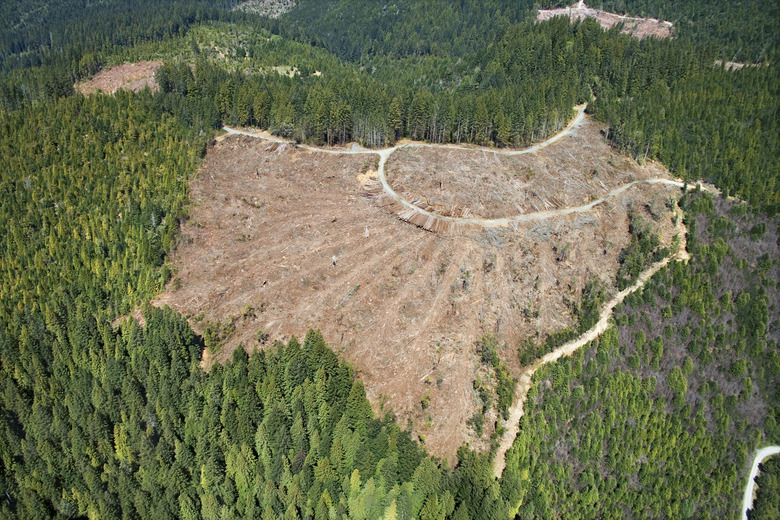Soil Erosion Due To Rainforest Deforestation
Erosion is a natural process that occurs in all environments. There are several causes of soil erosion, including wind, chemical weathering, and the freezing and thawing of water. However, the most significant cause of erosion is the flow of water. Natural ecosystems regulate erosion through intercepting water flow with vegetation and storing water within the soil structure. Human activities that clear vegetation and disturb soil structure increase the potential for degrading erosion to occur. Causes of soil degradation include deforestation, digging or otherwise disturbing the soil, and urban development.
Soil erosion from water is particularly problematic in tropical regions as rainforest soils are often very poor and fragile, and regular heavy rainfall can rapidly destroy soil structure and begin the process of erosion. Once started, erosion can spread rapidly unless measures are implemented to control the flow of water and protect the soil surface.
Importance of Soil
Importance of Soil
All soils, including tropical rainforest soil, are a vital component of the environment that humans and nature depend on for survival. Soils are complex ecosystems consisting of plant, animals, bacteria and fungi. Soils play fundamental roles in agriculture, flood control and the carbon and water cycle.
Soil Erosion in Rainforests
Soil Erosion in Rainforests
When the rainforest exists in a natural state, the soil is protected from the impact of rainfall in several ways. The canopy of the trees intercepts and holds much of the precipitation, allowing it to more slowly work its way to the ground. Trees may drip water from leaves and branches for considerable time after rainfall events, effectively extending the duration of the rainfall and giving the water more time to absorb into the soil.
On the ground, a layer of decomposing leaves, twigs and other materials, as well as ferns and low shrubs, absorb the impact of the falling raindrops and help protect the soil structure. Vegetation also acts as a physical impediment to water flows. Areas without vegetation experience greater water velocity, which increases its erosive potential.
Increased Frequency and Severity of Flooding
Increased Frequency and Severity of Flooding
When the soil surface is unprotected and exposed to the elements, it forms a crust that is far more impermeable than soil in its natural state. Therefore, when rainfall occurs, less water is absorbed into the soil and more washes downhill into rivers, lakes and wetlands. When extreme rainfall events occur, this can cause flooding in low-lying areas. Floods can damage houses and buildings, infrastructure such as roads and bridges, and agricultural crops and farmland.
Sedimentation Effects
Sedimentation Effects
When excess rainfall washes downhill, it carries with it particles of sediment. These are picked up by fast-flowing water on hillsides and is then deposited when the waters slow down in flatter areas. This deposition can damage plants and vegetation, both in agricultural and natural areas, and cause dams to "silt up" and become less effective. Sedimentation can require significant clean-up costs and effort when it occurs in urban areas.
How to Prevent or Reduce Erosion
How to Prevent or Reduce Erosion
Revegetation of areas that have been cleared is one of the most effective ways to prevent erosion. As well as intercepting and absorbing water, plants protect the soil surface and open channels in its structure, which increases water infiltration and storage. The best plants for this purpose are deep-rooted grass species, such as vetiver. Vetiver can be planted in rows across slopes to intercept and slow down water flow.
Another solution are earthworks such as ditches, canals and dams that intercept water flow. These can act as water reservoirs to store water, or direct water laterally across a slope rather than downslope. This reduction in water velocity greatly reduces its erosive potential. It is particularly useful in gullies, valleys and drainage channels.
Cite This Article
MLA
Michelle, Meg. "Soil Erosion Due To Rainforest Deforestation" sciencing.com, https://www.sciencing.com/soil-erosion-due-rainforest-deforestation-23042/. 30 September 2021.
APA
Michelle, Meg. (2021, September 30). Soil Erosion Due To Rainforest Deforestation. sciencing.com. Retrieved from https://www.sciencing.com/soil-erosion-due-rainforest-deforestation-23042/
Chicago
Michelle, Meg. Soil Erosion Due To Rainforest Deforestation last modified August 30, 2022. https://www.sciencing.com/soil-erosion-due-rainforest-deforestation-23042/
